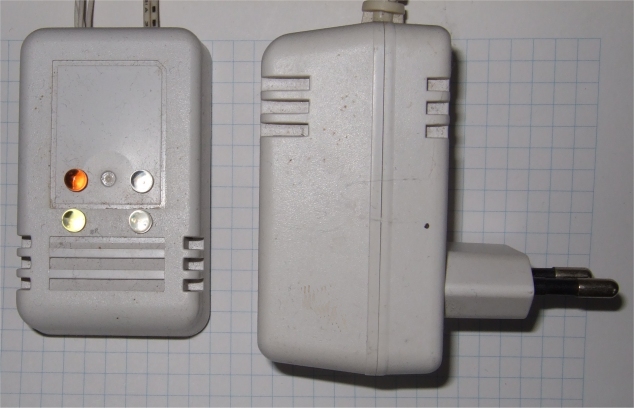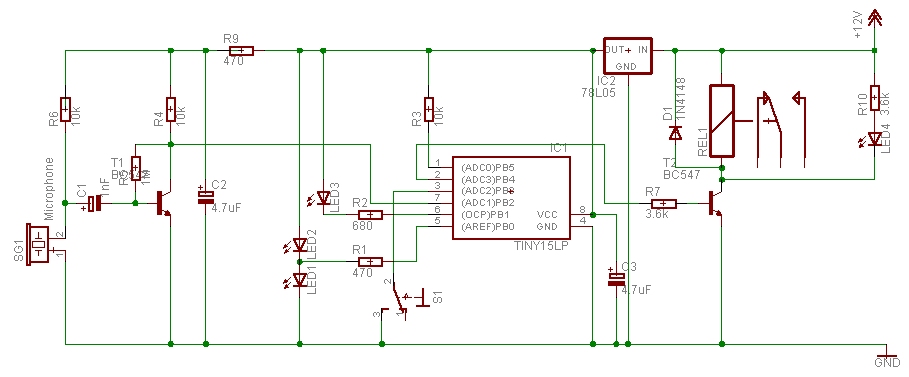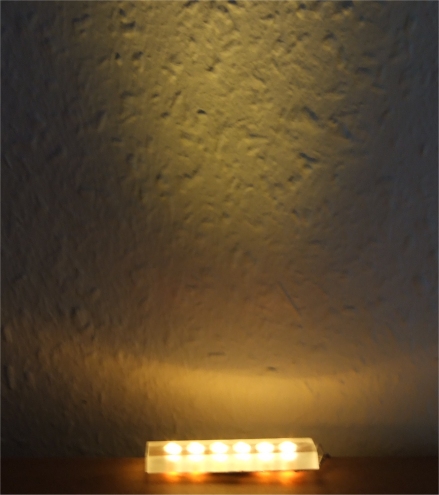Clap Switch with ATtiny15

This is a remote control which is using sound to switch a load. Clap your hands twice in a time window and the light goes on like magic.
A microcontroller allows a bit more control and error handling than conventional circuits. A microphone and the transistor pre-amplifier convert the sound to an electrical signal. This is basically the clap frequency of more or less 2 kHz which is measured with TC0 at input PB2. TC1 provides the time base for the whole circuit and here uses 100 ms gate time to measure the clap frequency. The red led3 turns on when a sound is present.
Now the number of pulses which are counted with TC0 are compared to two thresholds. This should avoid a false trigger and seem to work quite well. The definition .equ tooshort= 8 means count pulses are too few, may be a spike only, and .equ toolong= 180 means count is too long, it could be noise etc. TC0 counts between 8 and 180 are considered a valid clap signal and set a flag for the first accepted clap. The blue led1 turns on.
Now it waits for waitclap= 60 i.e. 600 ms then listens for the second clap. The time window is cwindow= 250, a window of 2.5 sec to receive the 2nd clap. If this 2nd is also a valid clap then the output PB4 is turned on and the relais switches. To avoid switching by the click of the relais there is a blocktime= 4 meaning 4 seconds sounds are blocked when the relais has switched. During this time the red led3 is blinking, led4 turns on. Now, if you clap twice again the relais turns off. Lights off, magic again.
These parameters can be changed in the program according to your own experiments. The waitclap time could be a bit shorter.

The circuit diagram of the clap switch. S1 is an optional manual push button and can turn the relais on or off.
When the program is waiting, the white led2 is on and the blue led1 blinks
once per second to show it is ready. This trick to switch 2 leds witch one output
pin works best with white and blue or green leds.
I have built different versions, in the one above PB4 is driving a power FET. The FET will turn on small 12V led lamps directly, no relais is used. That is why it can fit in a small box. The power supply is a simple wall plug for 12V DC and 300 mA.

One of the led lamps with sun-white leds.
All children will like this clap switch, it's fun to use.
download Klapp3.zip
This program is distributed in the hope that it will be useful but WITHOUT ANY WARRANTY;
References
Atmel datasheet ATtiny15, Atmel.com
Gerd's AVR assembler version 3.3: http://www.avr-asm-tutorial.net/gavrasm/index_en.html
;***************************************************************************
; AT15 Clap switch
; Clap Clap switches Relais on or off
; microphone input on PB2, T0 measures clap pulses
; manual switch on PB3
; ATtiny15 GS 11-2009
; The timing is adapted for 1.6 MHz
;
; This program is free software; you can redistribute it and/or
; modify it under the terms of the GNU General Public License.
; This program is distributed in the hope that it will be useful,
; but WITHOUT ANY WARRANTY;
;
;***************************************************************************
; ATtiny15 dip
; (RESET/ADC0) PB5 VCC
; (ADC3) PB4 PB2 (ADC1/SCK/T0/INT0)
; (ADC2) PB3 PB1 (AIN1/MISO/OC1A)
; GND PB0 (AIN0/AREF/MOSI)
;
;***************************************************************************
; PB4 output Relais act high
; PB3 input pull up, manual toggle switch
; PB2 input T0 counter
; PB1 output Led3 act low
; PB0 output 2 Leds + led--R--led -
;***************************************************************************
.DEVICE ATtiny15 ;for gavrasm
; PB0 plex 2 Leds
.equ Led3 = PB1
.equ Input = PB2
.equ toggle = PB3
.equ Relais = PB4
.equ tooshort = 8 ; count too short, not valid
.equ toolong = 180 ; count too long, noise etc
.equ waitclap = 60 ; 600 ms between 2 claps
.equ cwindow = 250 ; window 2.5 sec for 2nd clap
.equ blocktime = 4 ; 4 seconds blocked after relais switched
.def S = r4
.def zero = r5
.def temp = r16
.def countL = r17 ; main timing
.def countH = r18
.def counter = r19
.def upcnt = r20
.def Cnt0count = r21 ; Counter0 result
.def ClapCnt = r22 ;
.def flag = r23
.cseg
.org 0
; Reset-vector to adress 0000
rjmp reset
reti ; INT0addr= 0x0001 External Interrupt 0
reti ; PCI0addr= 0x0002 pin Interrupt
rjmp TIM1_Cmp ; OC1addr = 0x0003 Timer/Counter1 Compare Match
reti ; OVF1addr= 0x0004 Timer/Counter1 Overflow
reti ; OVF0addr= 0x0005 Timer/Counter0 Overflow
reti ; ERDYaddr= 0x0006 EEPROM Ready
reti ; ACIaddr= 0x0007 Analog Comparator
reti ; ADCCaddr= 0x0008 ADC Conversion Ready
;********************************************************************
;* "TIM1_Cmp" - Timer/counter 1 Compare Match interrupt handler
;*
;* interrupts every 10 ms, 40 x 250
;*
;********************************************************************
TIM1_Cmp: in S,sreg ; Updated every 10 ms, calibrate OSCCAL
;sbis PINB, toggle ; skip if set
;sbi PORTB, toggle ; set output PORTB, PINB0
;sbic PINB, toggle ; skip if set
;cbi PORTB, toggle
;inc upcnt
;cpi upcnt, 100
;brlo TIM1_1 ; 1 sec
;clr upcnt
;dec ClapCnt ; dec slowly
;brne TIM1_1 ; if 0
;clr ClapCnt ; keep on 0
TIM1_1: inc counter ; use to delay
inc countL ; main timing
brne TIM1_ex
inc countH
TIM1_ex: out sreg,S
reti
;***************************************************************************
reset:
; writing the calibration byte to the OSCCAL Register.
ldi temp,0x72 ; not really needed
out OSCCAL,temp ; for the clock
nop
clr zero
; Port B
ldi temp,0b00001010 ; set
out PORTB, temp ; 1 = pull-up , 0 = float
ldi temp,0b00010011 ; 1 = output , 0 = input
out DDRB, temp ; data direction register
;***************************************************************************
; timer1 setup:
;Timer/Counter1 Overflow Interrupt Enable
ldi temp,0b01000000 ; set Bit compare match interrupt
out TIFR,temp ; clear pending Interrupt
out TIMSK,temp ; set in the Timer Interrupt Mask Register
out TCNT1,zero ; Timer/Counter 1 clear
ldi temp,250-1 ; Timer/Counter 1 for 10 ms
out OCR1A,temp ; Bit 7 – CTC1: Clear Timer/Counter on Compare Match
ldi temp,0b10001011 ; Timer/Counter 1 clocked at CK/64 = 40 us
out TCCR1,temp ; 1,6 Mhz
; timer0 setup:
out TCNT0,zero ; Timer/Counter 0 clear
;ldi temp,0b00000111 ; Timer/Counter 0 external clock PB2 raising edge
out TCCR0,zero ; stop now
sbi AcsR, Acd ; Disable Comparator
cbi PORTB, Relais
sei ; Enable gobal iterrupt
;***************************************************************************
; test Leds at start
cbi PORTB, Led3 ; on
rcall BlinkLed ; delays 300 ms
rcall BlinkLed
rcall BlinkLed
sbi PORTB, Led3 ; off
rcall Ledoff
clr counter ; reset counter
rcall Led1
wait1led:
cpi counter, 50 ; 500 ms
brlo wait1led
rcall Ledoff
clr counter ; reset counter
rcall Led2
wait2led:
cpi counter, 50 ; 500 ms
brlo wait2led
rcall Ledoff
; wait for signal
main:
sbic PINB,Input ; If Input is
rjmp detecthi ; high - jump to detecthi
sbis PINB,toggle ; If toggle switch is
rjmp Rtoggle ; low - jump to Rtoggle
cpi countL, cwindow ; window 2.5 sec
brlo main
clr flag ; reset flag
rcall Led1 ; blue
rjmp main ; Input low - jump to main, wait for high
detecthi:
cbi PORTB, Led3 ; on
rcall Ledoff
inc ClapCnt ; count line high
sbrc flag, 7 ; 0 = first time
rjmp clrcnt ; 1 = 2nd time
clr countL ; reset main sw counters
clr countH ; 10 ms
clrcnt: out TCNT0,zero ; Timer/Counter 0 clear
ldi temp,0b00000111 ; Timer/Counter 0 external clock PB2 rising edge
out TCCR0,temp ; start Timer/Counter 0 counting now
clr counter ; reset counter
wait1st:
cpi counter, 10 ; 100 ms count pulses
brlo wait1st
sbi PORTB, Led3 ; off
in Cnt0count, TCNT0 ; get counter 0 counts
out TCCR0,zero ; stop now
out TCNT0,zero ; Timer/Counter 0 clear
; now check no of signals counted
cpi Cnt0count, tooshort ; count too short, not valid
brsh m1 ; filter spikes
rcall Led1 ; blue
clr flag
rjmp main
m1: cpi Cnt0count, toolong ; cnt ok 8 - 180
brsh m2
rcall Led2 ; white Led is on
inc flag
sbr flag, 0x80 ; bit 7 indicates first time ok
rjmp wait2nd
m2: ; cnt too high, noise etc.
clr flag
rcall BlinkLed ; delays 200 ms
rcall BlinkLed
rcall BlinkLed
rjmp main
wait2nd:
cpi counter, waitclap ; 60 = 600 ms between claps
brlo wait2nd
rcall Ledoff
rcall Led2 ; white
;cpi ClapCnt, 30 ; check if too many signals
;brsh waitblock ; block then
waitsee: cpi flag, 0x82 ; 2 claps and 2nd time
brne main
Rtoggle: sbis PINB, Relais ; toggle Relais
sbi PORTB, Relais ; PORTB
sbic PINB, Relais ; skip if set
cbi PORTB, Relais
clr flag
rcall Ledoff
waitblock:
sbrs counter, 4 ; use counter to blink
rjmp wbLedoff ; while waiting
cbi PORTB, Led3 ; on
rjmp wbCont
wbLedoff:
sbi PORTB, Led3 ; off
wbCont:
cpi countH, blocktime ; block some seconds
brlo waitblock ; after toggle Relais
sbi PORTB, Led3 ; off
rcall Ledoff
rjmp main
;***************************************************************************
; plex 2 Leds on PB 0
Led1: ; blue
sbi PORTB, PB0 ; high
sbi DDRB, PB0 ; output
ret
Led2: ; white
cbi PORTB, PB0 ; low
sbi DDRB, PB0 ; output
ret
Ledoff:
cbi PORTB, PB0 ; low
cbi DDRB, PB0 ; input
ret
BlinkLed:
sbi PORTB, PB0 ; high
sbi DDRB, PB0 ; output Led1
clr counter
Blink1: cpi counter, 10 ; delay 100 ms
brne Blink1
cbi PORTB, PB0 ; low
cbi DDRB, PB0 ; input Led off
nop
cbi PORTB, PB0 ; low
sbi DDRB, PB0 ; output Led2
clr counter
Blink2: cpi counter, 10 ; delay 100 ms
brne Blink2
cbi PORTB, PB0 ; low
cbi DDRB, PB0 ; input Led off
ret
